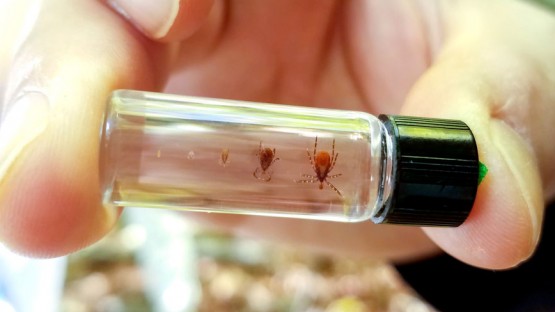New Cornell-led research shows that inadequate funding is the main barrier to better surveillance and control of ticks, including the blacklegged tick, which spreads Lyme disease, the No. 1 vector-borne illness in the country.
Insufficient infrastructure, limited guidance on best practices and lack of institutional capacity also are impediments to improved tick monitoring, the researchers found.
Their report, “A Survey of Tick Surveillance and Control Practices in the United States,” published June 17 in the Journal of Medical Entomology. The lead author is Emily Mader, program manager of the Northeast Regional Center for Excellence in Vector-Borne Diseases (NEVBD) and a member of the lab of Laura Harrington, professor of entomology, NEVBD director and a co-author of the study.
The study identifies what methods public health agencies use to track ticks, the barriers they have and what aid they might need. The study also generated a directory of tick surveillance programs, which did not exist previously.
Aside from Lyme disease, multiple tick species can infect people and animals with a wide variety of other pathogens. Public health and medical professionals have seen a dramatic rise in these tick-borne illness over the last 15 years.
“Vector-borne diseases are only going to become an increasing threat in the world, [including] the United States,” Mader said, “and we really don’t know how to address that threat unless we study it.”
Mader and colleagues surveyed 140 vector-borne disease professionals who work in state, county and local public health and vector control agencies. The survey addressed: tick surveillance programs; pathogen testing methods; tick control practices; how data is communicated; and barriers to developing and operating programs.
The results showed that close to half of the respondents were engaged in active tick surveillance, meaning they collect ticks from the environment. Nearly two-thirds engaged in passive surveillance – a kind of crowdsourcing where members of the public send in tick samples.
Active surveillance costs more as it requires trained personnel, transport and storage costs, but it offers more detailed location and ecological information that informs risk compared to passive surveillance. Some programs conducted no tick surveillance.
“If you want to know how the public health threat of ticks is changing from year to year, you need to have the data,” Mader said. “We found that [surveillance] programs just weren’t able to be sustained across time.”
Lack of access to pathogen testing services for many programs was another major barrier to getting better information about the public health threat of ticks in an area.
The survey also found that partnerships between tick surveillance programs within state health or agriculture departments often relied on academic partners. Universities may absorb some costs, provide diagnostic services and provide labor with student interns.
“The most prevalent barrier to developing and sustaining a tick surveillance program across time is just lack of funding,” Mader said. County programs often rely on funding from county taxes, while state programs receive state budget appropriations or federal grants.
Many existing programs are in areas where blacklegged ticks live; these communities may have a long history of tick-borne illness.
The survey has already provided important information to bridge knowledge gaps, Mader said. One of the biggest barriers for effective tick surveillance has been lack of standardized guidelines on how to survey the environment for certain tick species, each of which behave uniquely, live in varying habitats, and are collected in different ways.
In response this need, the Centers for Disease Control and Prevention (CDC) recently issued two documents on collecting ticks from the environment.
NEVBD will work to identify more such gaps and provide the knowledge or resources that people need, Mader said.
Co-authors included researchers from Texas A&M University; the University of Florida, Gainesville; the University of California, Davis; the University of Illinois, Urbana-Champaign; and the CDC.
The study was funded by the five Regional Centers of Excellence in Vector-Borne Diseases.
















